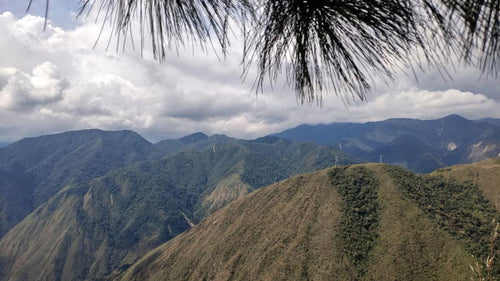
WHEN THEY GO LOW
APRIL 23, 2023 | Written by Lars Pilengrim

Ibelieve Michelle Obama were onto this topic already back in 2016 with her quite so famous;
“When they go low – we go high”.
But I however think she forgot to paint the full picture for us.
Please allow me:


Throughout the world of specialty coffee, it is commonly known that high altitude tends to improve on coffee quality. If you’ve been around coffee packaging for a while you’ve probably come across the little lines stating the specific altitude of where that farm is located and hence in which elevation that coffee has been grown at. It’s simply put one of the key things to look for when scouting for good quality as the higher the altitude, the better the coffee. But how come?
”The altitude simply shines in this example”

The cooler mountain temperatures help to slow down the overall growth rate of the coffee plant. Something that makes the cherries mature slower with as well a bigger difference between day- and night temperatures. This slow growth results in a denser bean with a more developed chemical composition and hence concentrated flavor profiles. High altitude coffees tend to have a higher level of acidity with a brightness that presents fruity and floral taste notes, something that’s highly sought for amongst the coffee connoisseurs.
This knowledge has helped shaped the industry and created categories such as SHG Arabica, simply referring to “Strictly High Grown Arabica”. In most cases meaning that the coffee has been grown at altitudes above 1200 meters above sea level. A tool and indicator, helping coffee buyers scour through the masses looking for the good stuff.
One clear evidence that supports the above thesis is the Lykke Can Fly High coffee. Grown at the quite extreme altitudes of up to 2300 meters in the Peruvian Andes the coffee cherries have matured far longer on the trees compared to its 500-meter lower equivalent coffee trees found in the region. And therefore, harvested much later in the season. Thanks to this it has become a very dense bean that has combined an impressive number of components that in the cup showcases just those vibrant and bright flavor notes as of florals and citrus fruits.
The altitude simply shines in this example.

But as like in much in life, these talks on altitude demands a bit of context. And to be challenged.
One part of the context could be that of latitude.
Latitude in coffee on the other hand refers to the distance between the equator and where the coffee has been grown. We very often talk about the coffee belt, which refers to the defined area between 25 degrees north and 30 degrees south of the equator, all throughout America, Africa and Asia.
Coffee grown close to the equator enjoys a more even spread of sunlight throughout the year, as there is less variance in seasonal changes. Thanks to this it also tends to offer a more consistent yearly temperature that helps prolong the growing seasons. Or even create additional coffee harvesting seasons, as we experience in for example Uganda where we now operate.
Coffee grown farther away from the equator instead experiences distinct seasonal changes, where the winter season in some coffee-growing areas of Brazil in fact sometimes even hit freezing degrees. Meanwhile the summer season offer a tropical like climate with ample caiprinha-temperatures. The shift between the seasons makes a great impact on coffees ability to grow and in order to reach the adequate average temperatures the altitudes of coffee farms are located at much lower elevations.

”Coffee simply won’t grow at 2300 meters of elevation in Brazil. Or Kebnekaise’s 2096 meters in northern Sweden for that matter. ”
Coffee simply won’t grow at 2300 meters of elevation in Brazil. Or Kebnekaise’s 2096 meters in northern Sweden for that matter.
So, when we look at Lourival Mageskis farm in Espirito Santo in Brazil, one could quickly argue that the coffee isn’t the general “SHG Arabica” as it is grown at a mere 1000 meters above sea level.
But when we take latitude into account and look at the specific terroirs of Lourivals farm Sitio Abundancía there is clear resemblance to that of the Peruvian example above.
Low average temperatures to slow down the general growth of the plant and prolong the cherry maturation. And at the same time good variations in night and day temperatures to get the beans fully packed with deliciousness. All in all, creating ideal conditions for his coffee to showcase some truly unique characteristics. With a spectrum of sugary sweetness, bright acidity and notes of sweet pomelo and grapefruit.
What I’m saying is simply put;
Keep your eyes on the altitude, but don’t forget the latitude as it as well plays a vital role!
Try it yourself with the “Fly High or Go Low”—the ultimate altitude/latitude—and flavor bundle.

EXPLORE OUR FARMS


